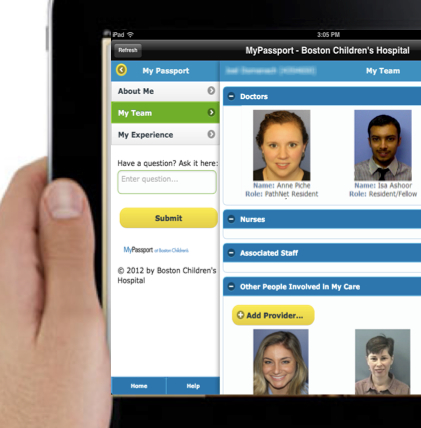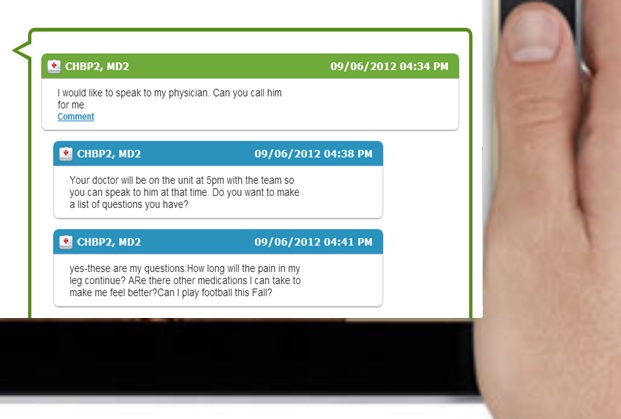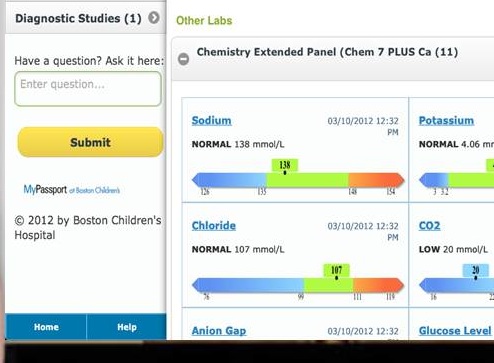 In just a 24-hour period, patients in the hospital typically see a variety of doctors, nurses, x-ray technicians and other medical professionals, and undergo a plethora of diagnostic tests—without an understanding of how all of it comes together to make them well.
In just a 24-hour period, patients in the hospital typically see a variety of doctors, nurses, x-ray technicians and other medical professionals, and undergo a plethora of diagnostic tests—without an understanding of how all of it comes together to make them well.
The Diversity and Cultural Competency Council (DCCC) at Boston Children’s Hospital recently conducted a three-year study on patient satisfaction. It found that the main reason patients were sometimes dissatisfied was because they felt unfamiliar with the medical information they were receiving, and had difficulty understanding who was part of their care team and how best to communicate with them. And so the idea of MyPassport was born.
A paper passport
It began as a paper booklet with pictures and titles for every care team member, and pages for lab test results and summaries. Patients could curate their information in one place, understand the roles of the people who rotated in and out of their rooms, track their treatments and learn what their lab results meant. The booklet also included the patient’s plans for the next day, a place to write down questions for their providers and information about being discharged.
“It empowered parents and improved the communication and coordination of care,” says Marilyn Moonan, RN, BSN, CPN, CCTN, a member of the DCCC research team. “Families felt part of the medical decision-making process.” Overall, patients and families who used MyPassport reported better understanding and fewer instances of miscommunication.
But hospital clinicians wanted to go to the next level. Updating the paper booklets with data was time-comsuming and inefficient, making it difficult to scale up the project.
Through a Boston Children’s Hospital FastTrack Innovation in Technology (FIT) award from the Innovation Acceleration Program, the team got access to experienced software programmers for rapid cycle development. With these resources, MyPassport graduated to an iPad application.
Going digital
The app automatically pulls patient data from electronic medical records in Epic and Power Chart, and displays it in a way that’s meaningful to patients and families. It helps patients proactively engage with their care team to get their questions answered, and feel more prepared to leave the hospital, armed with home care instructions.
 “We see MyPassport as a new opportunity to deliver real-time, personalized health information to patients and their families, and to enhance and change care delivery dynamics,” says Naomi Fried, chief innovation officer.
“We see MyPassport as a new opportunity to deliver real-time, personalized health information to patients and their families, and to enhance and change care delivery dynamics,” says Naomi Fried, chief innovation officer.
The app is in a small pilot trial, with the goal of eventually providing it to more patients on other inpatient floors. “We want to test the MyPassport prototype in an environment where we can learn about what works and doesn’t work with this new form of electronic interaction,” says Alex Pelletier, FIT program manager, who is leading the technical development team.
Preliminary survey data indicate that 90 percent of participants to date find it easier to get their child’s health information.
 Take test results. Paper-based blood-draw results come on a piece of paper with the letters L and H, which can be confusing to parents. Now, a computer translates the result to display whether it is normal or abnormal, and where the patient falls on that spectrum. Parents can reference the lab and have a dialogue with their provider about why a result is abnormal, and what that means.
Take test results. Paper-based blood-draw results come on a piece of paper with the letters L and H, which can be confusing to parents. Now, a computer translates the result to display whether it is normal or abnormal, and where the patient falls on that spectrum. Parents can reference the lab and have a dialogue with their provider about why a result is abnormal, and what that means.
Also helpful is being able to ask questions when the provider is not in the room—in an instant-message-like format that allows the provider to answer remotely. Often, doctors come to see a patient at a specific time, give the family specific information and then leave, before the family can process the information and ask meaningful questions.
The iPad version of MyPassport also takes a lot of fear out of going home, often a jarring experience for families. The care team enters a list of goals for each patient—such as standing or walking—to help determine when he is ready to go home. During their hospital stay, the patient and family can track their progress and feel more in control.
What lies ahead
Once the pilot testing ends, the team plans to roll out MyPassport in other languages and to patients not just on other floors, but in other countries—allowing a doctor or referring embassy to log in to the patient’s Passport to see how the child is doing, his lab results, and the family’s questions and concerns.
In the future, MyPassport could also benefit patients outside Boston Children’s: Other health institutions may be able to use MyPassport to care for their patients, and there’s talk of future collaboration with development partners to take the application to the next level.
For now, the application is changing the experience at Boston Children’s, one patient at a time. Families are becoming more involved in their care—and enjoying it.






